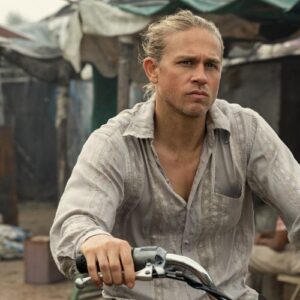The Vista Theater
“It’s the details that sell your story. And you have to make them your own.”
I learned that lesson in the art of storytelling on Friday, October 23, 1992. But I didn’t learn it in school.
I learned it at the movies. I was in the audience to see Reservoir Dogs, Quentin Tarantino’s directorial debut, at the Vista Theater, an aging movie palace at Sunset Junction on the border of Hollywood and Silver Lake.
Tarantino was a 28-year old last employed at Video Archives, a video shop in a mini-mall in Manhattan Beach. I knew the place from when I lived on the Marina Peninsula in Venice Beach in the late 1980s. In those days, the two video stores worth the drive from the Peninsula were Vidiots in Santa Monica and Video Archives in Manhattan Beach. Both shops had their merits, but I leaned towards the rock-n-roll vibe at Video Archives over the grad student vibe at Vidiots.
Today, Tarantino is an Oscar winner with nine feature films and a slew of side projects under his belt. He published one book and has another on the way. This year, he started a podcast with Roger Avery and Avery’s daughter Gala, named after the video store where Quentin and Roger met in the 1980s. He has become an adjective; enshrined in 2018 the Oxford English Dictionary:
Tarantinoesque: Resembling or imitative of the films of Quentin Tarantino; characteristic or reminiscent of these films.
Tarantino’s films are typically characterized by graphic and stylized violence, non-linear storylines, cineliterate references, satirical themes, and sharp dialogue.
But thirty years ago, in 1992, Tarantino came from so far out of left field, and so far off the Hollywood A-List, that, as he has put it, “I may as well have been from the fucking Yukon.” His resume was so thin that he padded it with lies about non-existent roles in Jean-Luc Goddard’s King Lear and George Romero’s zombie movies. With his phony resume and crime movie script in hand, and with a string of unpaid traffic tickets and outstanding warrants on his record, Tarantino drove all over Los Angeles tilting at windmills to raise money to finance Reservoir Dogs. In a twist worthy of Cervantes, his script bounced from producers to agents to stylists and finally landed in actor Harvey Keitel’s hands. Keitel, to his eternal credit, thought the script was so authentic that he set up a meeting to find out how Tarantino learned so much about the mean streets of “tough-guy neighborhoods.”
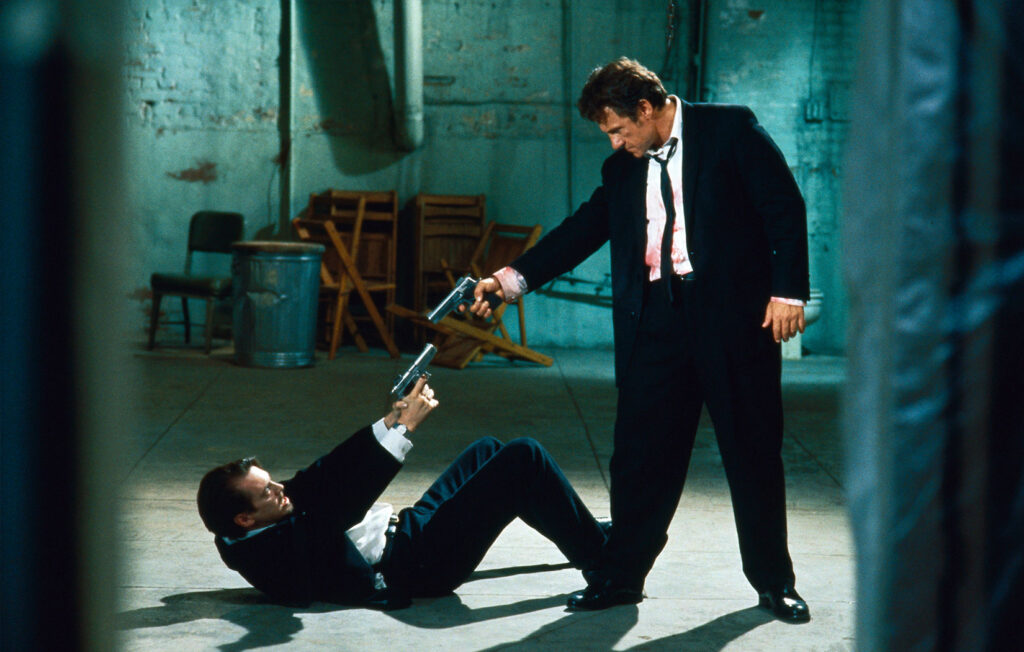
According to Tarantino, he told Keitel, “I watch movies.”
That was enough for Harvey. Keitel signed on as a producer and star of the film. His presence gave Tarantino what he needed to raise a million dollars and make a blood-spattered heist film about everything, and anything, except the heist. A foul-mouthed caper movie that showed the run-up to the caper, and the gruesome aftermath, but not the caper itself. A 99-minute movie about a robbery that found time for breakfast and bickering, for black suits and track suits, for Madonna, John Holmes, and Get Christie Love, for jokers, for clowns and K-Billy’s Super Sounds of the Seventies, but not a single minute for the robbery.
In October 1992, I didn’t know anything about Reservoir Dogs’ back-story. What little I had heard about the movie were reports in the Los Angeles Times about walk-outs on the film when it premiered at the Sundance Film Festival earlier in the year. The Times described the audiences in Park City as offended by the “gratuitous violence.”
Remember, in the early nineties no one had a smart phone. The iPhone had not been invented. We used beepers. And pay phones. The internet was still a novelty, and social media platforms didn’t exist. We chose the movies we wanted to see according to Siskel and Ebert’s imperial thumbs – up or down – or from movie reviews in newspapers we bought from the local newsstands that were everywhere in Los Angeles then, many open all night. On the morning of October 23, 1992, I picked up my copies of the Los Angeles Times and New York Times at the newsstand at Pico and Robertson in Baja Beverly Hills.
In the Los Angeles Times, Ken Turan dismissed Reservoir Dogs as “a showy but insubstantial comic opera of violence” and Tarantino as “one-dimensional.”
Vincent Canby, in the New York Times, saw things differently. Aficionados will know that in 1992 the paper published a “cast and crew” credits box embedded in the movie reviews to make the movie reviews look like theater reviews. The Reservoir Dogs credit box identified Tarantino as the writer and director. The review also had a black and white photo insert of a slick looking actor named Tim Roth wearing a leather jacket and a white tee shirt. I was not familiar with Roth, a British actor, but what Canby had to say about the movie caught my attention:
“Reservoir Dogs moves swiftly and with complete confidence toward a climax that matches Hamlet‘s both in terms of the body count and the sudden, unexpected just desserts. It’s a seriously wild ending, and though far from upbeat, it satisfies. Its dimensions are not exactly those of Greek tragedy. Reservoir Dogs is skeptically contemporary. Mr. Tarantino has a fervid imagination, but he also has the strength and talent to control it.”
A crime movie with “a climax that matches” the cathartic Fifth Act of Hamlet?
I tossed my copy of the Los Angeles Times aside, pocketed the Arts Section of the New York Times, and cut out of work early.
The First Crime
When I arrived at the Vista, I expected a crowd. Instead, I was practically alone. Maybe I was the only person in Los Angeles who cared about Vincent Canby or the Fifth Act of Hamlet. Or maybe it was the Santa Ana winds that were blowing hot in Los Angeles that day, raising dust, emptying the streets and exposing the desert hidden beneath the tinsel.
Whatever the reason, only three people were in the audience for the early show. Only two of us had purchased a ticket.
I was at the concession stand, ticket stub in hand, waiting for the usher to fill my popcorn order, when I saw a big man in a blue and gold Los Angeles Rams jersey – Number 11 – walk past the ticket booth without stopping. The usher with my popcorn asked big Number 11 if he wanted to buy a ticket. Number 11 stopped, thought about the inquiry for a moment and then simply said, “No.” The usher considered this answer, and decided, wisely I thought, to return to my popcorn order and let big Number 11 pass.
Reservoir Dogs had not even started and I had already witnessed the first crime. I followed big Number 11 into the theater and waited for the lights to go down.
Mind On Fire
When the lights came back up, everyone in the audience, all three of us, starting clapping. We knew we had seen something special.
Not many people bought the Velvet Undergrounds’ first album, White Light White Heat, but according to Brian Eno, everyone who did started a band.
Even fewer people caught the Sex Pistols June 4, 1976 gig at Manchester’s Free Trade Hall, but according to Steve Coogan, the gig changed the world for everyone who did.
Only three people caught the early showing of Reservoir Dogs at the Vista Theater in Hollywood on October 23, 1992, and while I can’t speak for big Number 11, I know I left the theater with my mind on fire and I knew had to document what I had experienced.
I drove east on Sunset, back to my office on the 12th floor at the old Federal Courthouse on Spring Street in downtown Los Angeles. The building was closed but the U.S. Marshal on night duty let me in. I went to my office, turned on my computer and got to work.
I had gone to Reservoir Dogs to clear my head before my first trial as a federal prosecutor, a conspiracy case set to start in federal court at 9:00 a.m. on Tuesday, October 27. I was facing a hardened bank robbery crew and my star witness was a former member of the crew prepared to testify against his partners in crime. I thought a movie would give me a break from the grind of pre-trial prep. I didn’t expect to receive a masterclass in the art of storytelling so powerful that I immediately took what I learned from the film to entirely revise the script for my upcoming trial and make it my own.
“It’s the details that sell your story. And you have to make them your own.”
In Tarantino’s script, those words belong to a plainclothes cop named Holdaway, the handler for an undercover cop named Freddy Newyandyke. Freddy, posing as Mr. Orange, has infiltrated crime boss Joe Cabot’s robbery crew. Holdaway is teaching Freddy the ropes. An undercover officer is known as a UC, and a UC is very different from a CI, or confidential informant. UCs are cops. CIs are not. Huggy Bear is a CI. In Reservoir Dogs, Long Beach Mike is the CI, and as we shall see, Long Beach Mike is just about as far from Huggy Bear as Cujo is from Lassie.
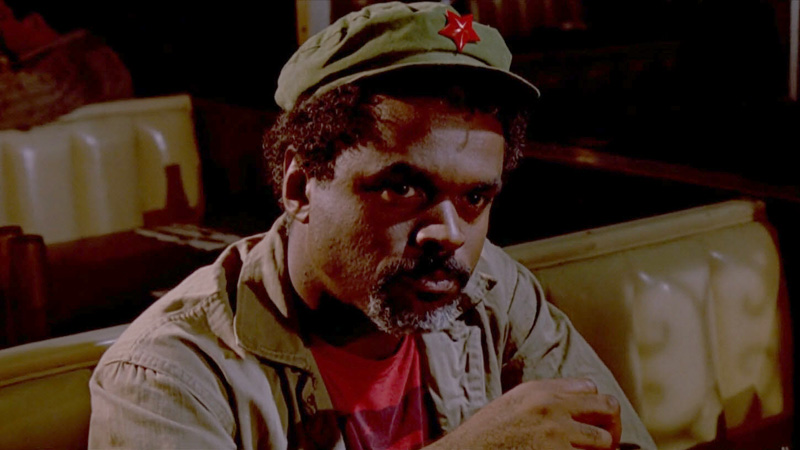
Tim Roth plays Freddy Newandyke, aka Mr. Orange. Randy Brooks plays Holdaway. I had never seen Randy Brooks before Reservoir Dogs and I haven’t seen him since, but I think his performance in Reservoir Dogs is one of the best “one-hit wonder” performances in any crime movie.
It is also the most overlooked performance in the movie.
Maybe it was because Brooks was sharing the screen with Tim Roth who had the juicer role as the UC, and who was making the most of the role. Maybe it was because he was also sharing billing with Steve Buscemi, Michael Madsen and Harvey Keitel who were all lighting up the screen in their roles as Mr. Pink, Mr. Blonde, and Mr. White.
Maybe it was because Brooks lost screen time when his scene at an outdoor burger stand with Roth and actress Nina Siemaszko, playing Detective Jodie McCluskey, was cut from the theatrical release. All of Nina Siemaszko lines were cut, but Detective McClusky has been resurrected – complete with her red leather jacket and Big Kahuna burger – as an extra on the DVD and Blu-ray releases of the film.
I personally believe that Brooks gets overlooked because he is too convincing in the role. So convincing that he almost disappears. I enjoy the six minutes Brooks and Roth share the screen so much that I rewatch the sequence before every jury trial. To borrow Dwyer Murphy’s comment about the Tom Hardy-Ricki Tarr sequence in Tomas Alfredsen’s under-rated Tinker Tailor Soldier Spy, I want to live in the Mr. Orange sequence.
Mr. Orange
That’s how it starts. With a black screen and a title card.
We immediately flashback to a resurrected Tim Roth striding into a diner with a grin on his face to join Brooks in a booth. Brooks is the first, and only, African American face in the film. Brooks is sporting a Chairman Mao cap. You better believe I got myself one of those caps. It is a little tattered now, but still hanging in my office.
The script identifies the diner as a Denny’s, but this is actually Johnie’s Coffee Shop on Wilshire Boulevard’s Miracle Mile. Johnie’s is also where Anthony Edwards learns of the apocalypse in Miracle Mile, where Ed Norton and Ed Furlong meet in American History X, and where, in The Big Lebowski, Walter and the Dude talk about Vietnam and practicalities of locating a severed toe.
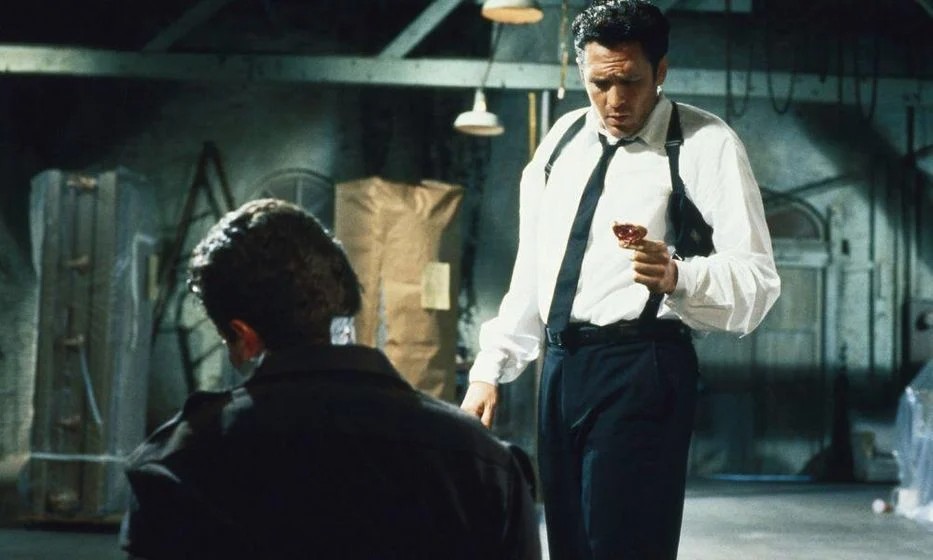
Now, Johnie’s is playing the role of Denny’s, and Tim Roth the actor is playing the role of Freddy Newandyke, the cop playing the role of Mr. Orange. Over the next six minutes, we will flash back and forward within this flashback and Brooks will stand in for Tarantino and play both the director and the writer rehearsing Roth in the role that, as Freddy, he will have to sell as fact.
But now, in the past, Tim Roth is all smiles because he has infiltrated Joe Cabot’s gang. “Say hello to a motherfucker who’s inside” Roth says. Roth explains that he is now “Mr. Orange,” and that he met with Cabot at a bar called “Smokey Pete’s” in Gardena. Gardena is a landlocked city in the South Bay, east of Torrance, the town where Tarantino grew up. Gardena is popular with both cops and criminals for its casinos and strip clubs. Tarantino used the Lodge in North Hollywood to stand-in for the fictional Smokey Pete’s. In Pulp Fiction, Tarantino made it to Gardena using Starz, a strip club in the city, as the setting for a meeting between Butch and Marcellus Wallace.
The conversation turns to Long Beach Mike, the CI who vouched for Freddy so he could gain access to the Cabot gang. Now Roth wants to vouch for Long Beach Mike, telling Brooks he has to take care of Long Beach Mike because he is “a good guy.” Brooks looks Roth in the eye and he is no longer smiling. What Brooks says next are most authentic words on the subject I have ever heard.
“Long Beach Mike is not your fucking amigo. Long Beach Mike is a fucking scumbag. He’s selling out his amigos. That’s what kind of a nice guy he fucking is. All right? I’ll take care of his ass, but you get that lowlife scumbag out of mind and you take care of business. You hear me?”
Before we have any time to think about Long Beach Mike’s future prospects, we are transported to an abandoned rooftop in the Los Angeles sun, abandoned by everyone except Brooks and Roth, two Princes of the City who can go anywhere they please and wear anything they choose. Brooks isn’t even wearing a shirt. Just a samurai headband and a sleeveless blue jean vest.
Brooks hands Roth a script he has written and then directs Roth on his performance telling him, “An undercover cop has got to be Marlon Brando. To do this job you got to be a great actor. You got to be naturalistic. You got to be naturalistic as hell.”
What follows is a classic set piece – the training vignette – a staple of the action movies Tarantino raves about in his podcast with the Averys. But this time around, Roth was not the only student. I was taking notes too.
Brooks explains the vital importance of having an “amusing anecdote” to tell, one that Roth will need to learn – and learn cold – if he is going be able to fake it enough to make it into Joe Cabot’s gang. The speech Brooks delivers next deserves to be quoted in full:
The things you gotta remember are the details. It’s the details that sell your story. Now, this particular story takes place in a men’s room. So, you gotta know all the details about the men’s room. You gotta know if they got paper towels or a blower to dry your hands. You gotta know if the stalls ain’t got no doors or not. You gotta know if they got liquid soap or that pink, granulated powder shit they used in high school. Remember? You gotta know if they got hot water or not, if it stinks, if some nasty, lowlife, scum-ridden motherfucker, man, sprayed diarrhea all over one of the bowls. You gotta know every detail there is to know about this commode. What you gotta do is take all them details, man, and make ’em your own. While you’re doing that, you gotta remember that this story is about you and how you perceived the events that went down. The only way to do that is to keep sayin’ it and sayin’ it and sayin’ it.
Tom Shone, who may be Tarantino’s most perceptive critic, has called Brooks’ speech “as close to an aesthetic credo as Tarantino ever got.” I agree with Shone, and add that Brooks, going undercover as Holdaway, is also teaching a lesson in how to tell telling a convincing story, a lesson – “the story of you” – that may be the most personal scene Tarantino has ever written, and that has served me well in court for thirty years.
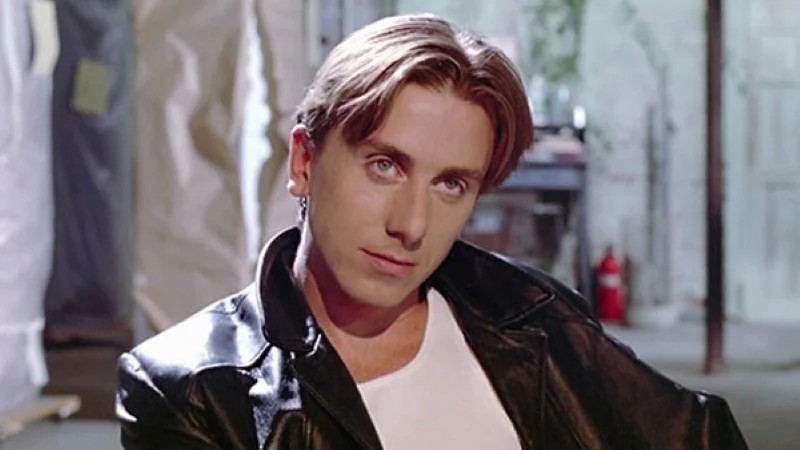
After watching Roth rehearse his story at his apartment, we cut to Roth, no longer the student, now in command of the story, bringing it life on stage for Brooks in front of the graffiti sprayed walls of the abandoned Toluca Substation at the junction of Beverly Boulevard, Second Street and Toluca Street, one mile from downtown Los Angeles. This location is identified as “Ext. Rooftop Day” in the script, but whoever decided to move the scene to the Substation deserves a medal. Touluca Substation was near Beverly Station, a hub for Los Angeles’ once prosperous trolly system. I admired this location so much that I made a point of finding it after seeing the film and used it as a setting to practice my closing arguments. In the 2000s, Beverly Station was repurposed as the box-like Belmont Station Apartments and the mesmerizing graffiti at the Touluca Substation was painted over in government gray.
After watching Mr. Orange perform his “amusing anecdote” about copping weed during a dry spell at Smokey Pete’s for Cabot, Nice Guy Eddie and Mr. White, a virtuoso scene that includes four Los Angeles County Sheriff’s Deputies and one inquisitive German Shepherd, we make a final flash forward within the flashback to Roth in his apartment. He is preparing to assume his Mr. Orange identity and meet the gang. Before he heads out, Roth stops before the mirror to stare into his own eyes and say:
“Don’t pussy out on me. They don’t know. They don’t know shit. You’re fucking Beretta.”
Roth was looking into the mirror and telling himself that they don’t know you are a fake. Telling himself to bluff it out, to fake it kid, until you make it.
I know that mirror. I have told myself those same words.
And I’m betting Quentin Tarantino knows that mirror too. Tarantino was writing for Mr. Orange, but he was talking to himself. Talking to the kid from Torrance, the kid from the video store, the kid from the fucking Yukon, the kid with the phony resume. Telling himself that he was going to make it.
Well, the kid from the Yukon has made it pretty far. Tarantino has made it so far that, in his spare time, he rescues classic movie houses in Los Angeles from oblivion. A few years back he saved the Beverly Cinema in mid-city. Then, last year, after the Vista Theater closed during the global pandemic with no plans to reopen, he rescued it too. Variety has reported that Tarantino bought the Vista with plans to renovate it and reopen it as a combination film house and arcade.
When the Vista does re-open, I hope Tarantino screens a thirtieth anniversary print of Reservoir Dogs. If he does, I’ll be there.
















